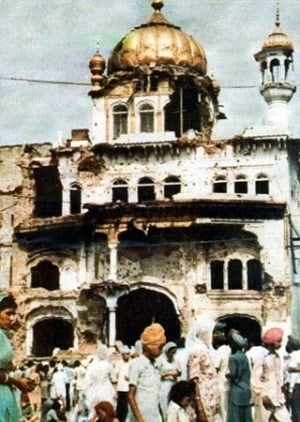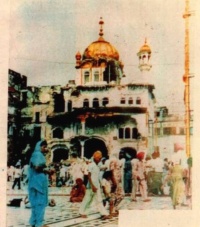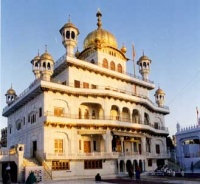Operation Bluestar

Operation Bluestar
Background
On 13th April 1977, head of Naqli Nirankaris named Gurbachan led a procession in Amritsar. Earlier he had declared that "If Guru Gobind Singh can make five beloved one's., he will make seven stars" . Naqli Nirankaris are strongly associated with Arya Samajis and other such organization which came out of need to reform Hinduism, from its age old superstitions and rituals., but these movements instead of targeting common Hindu individuals spearheaded their movement against Sikhism. Arya Samajis and Naqli Nirankaris wanted Sikhs to start shaving and to drop their individuality and assimilate into Hinduism (or their form of Hinduism with rituals like "Havan"). So on this occasion of Vasakhi, Gurbachan Nirankari led a procession in Amritsar. Bhindrenwale at this time was a small time preacher, who would visit villages and preach to youngsters to adopt Sikh practices. Akhand Kirtani Jatha with its leaders set out from Akal Takht to stop Gurbachan Nirankari for his act of "Creating five stars". Gurbachan and his armed accomplice fired at these Akalis and one by 13 Akalis were killed.
After this incident, Bhindrenwale's reputation as a fierce emerging Sikh leader rose tremendously in Sikh political circles. From 1977 until 1983, Bhindrenwale led his agitation against Arya Samajis and other fanatic Hindu organizations who were working against Sikh and ncept of Punjabiat as well as many Sikhs who opposed him for his fanatical views. Many of his followers were young rural Sikhs, who had been disappointed with state and central government due to unemployment, poverty and other problems. After 3-4 years of trial, Gurbachan of Nirankari sect was acquitted by Indian court, even though more then 10 person testified against him in court, it was clearly evident that there were political heavy weights behind him as well as behind Bhindrenwale.
Till 1983 about 500-1000 persons were killed all over Punjab by armed brigades of young motor cycle driving terrorists who would suddenly appear and with one burst of machine gun kill 10-15 people. Prominent Arya samaji leaders and news paper publishers of Hind Samachar group like Lala Jagat Narain was killed by unidentified persons and Government of India implicated Bhindrenwale and arrested him at Chowk Mehta in 1982, but he was released in two days. Then, in later half of 1982 he moved to Golden temple complex where he setup his headquarters in Guru Ram Das Sarai. In 1984 he moved to Akal Takht. Indira Gandhi and government of India declared president rule in Punjab and deployed 4 division of Army through out Punjab, in a desperate attempt to flush out Bhindrenwale and his accomplice from Golden Temple complex. Then it all started, I quote from much accomplished book called "Amritsar Mrs. Gandhi's Last battle", by Mark Tully and Satish Jacob "At Seven o'Clock on the evening of 5th June, tanks of the 16th Cavalry Regiment of the Indian army started moving up to the Golden Temple complex. They passed Jalianwala Bagh, the enclosed garden where General Dyer massacred nearly 400 people. That massacre dealt a mortal blow to Britain's hopes of continuing to rule India and was one of the most inspirations of the freedom movement. When Mrs. Gandhi was told that Operation Blue Star had started,she must have wondered whether it would provide the decisive inspiration for the Sikh independence movement, a movement whch at that time had very little support outside Bhindrenwale's entourage and small groups of Sikhs living in Britain, Canada and the United States. Major-General Brar was leading a mixed bag of troops, representative of the widespread recruiting pattern of the modern Indian army, which has broken with British tradition of limiting recruitment to certain 'martial castes'. There were Dogras and Kumaonis from the foothills of the Himalayas, India's northern border. There were Rajputs, the desert warriors from Rajasthan. There were Madrasis from Tamil Nadu, one of the most southern states. There were Biharis from the tribes of central India, and there were some Sikhs. Major Brar had joined Maratha Light infantry 30 years ago in 1954 as a lieutenant. He had fought in Bangladesh under Lieutenant-General Jagjit Singh Aurora, the Sikh general who was most outspoken critic of the Operation Blue Star."
Bhindrenwale and his group had moved to Akal Takht, the highest seat of Sikh authority few weeks before Army attack. He had been criticized for this act as he became the only person after Guru Hargobind to live in Akal Takht. He was obviously spearheading the last showdown with Indian army and had knowledge that sooner or later Army would attack and he himself wanted to go down in Sikh history as a martyr and not deserter or negotiator as other Akalis political leaders. He had support of Major General Shabeg Singh, unofficial hero of Bangladesh war., as well as thousands of rural Sikh youth.
Brar's superior officer was Lt-General Krishnaswamy Sunderji, who asked his chief staff Officer, Lt-General Ranjit Singh Dayal, to draw up the plans for Operation Blue Star. Dayal, like Brar was a Sikh, but he had not shaved his beard or cut his hair, and still wore a turban. Dayal was also an infantry soldier, having served in the Ist Battalion, the Parachute Regiment, which was to spearhead the attack on the Golden Temple Complex. During the 1965 war with Pakistan, Dayal became legend by capturing a pass which had previously been thought to be impregnable, and blocking off one of the most important routes from Pakistan-Controlled Kashmir into Indian state of Jammu and Kashmir. A frontal assault was impossible and so Lt-General Dayal climbed up the mountains towering over Haji Pir pass and came down on top of the Pakistanis.
Dayal, Sundarji and Brar drew up at twofold plan. The essence of this plan was to separate the hostel complex from the Temple complex so that the hostels could be evacuated without becoming involved in the main battle. To achieve the prime objective to get Bhindrenwale out of the temple complex they had planned a commando operations. Commandos were to be supported by infantry, Tanks were only to be used as platforms for machine guns to neutralize fire on troops approaching the Golden Temple complex, and to cover the Temple exits in case anyone tried to escape. Armored personnel carriers were to be positioned on the road separating the hostels from the Temple complex to keep the two potential battle fields apart.
Operation Bluestar
Operation Blue Star
Singho dont use this site to spread hatred. Overcome Kaam, krodh, lobh, etc. Hatred is not an attribute of a Sikh. Bhul Chuk maaf
Operation Blue Star - Aftermath
Aftermath of operation blue star was not different from other attacks on Golden Temple in previous centuries. To make matter worse, Indian army simultaneously attacked 40 other historical Gurdwaras all over Punjab. It was reminiscent of Ahmad Shah Abdali's invasion where Abdali forces had destroyed all the Gurdwara in his path. About 5000 soldiers of Sikh regiment of Indian army as well as other institutions rebelled against Government of India. Many prominent sikh leaders and theologians who had been honoured by Indian government returned their medals and certificates. This attack only alleviated the secessionist movement and overnight Bhindrenwale became a folk hero. It is a known fact that more people died after this attack in next two years then from 1977-1984 while the attack on golden temple was to curb the "seccessionist movement". It was obvious that sooner or later Indira Gandhi will have to suffer for this destruction. In November of same year, two devoted Sikhs named Beant Singh and Satwant Singh in Delhi police who were posted at Indira Gandhi's residence in New Delhi, killed her. Then riots against Sikhs followed in Delhi, Kanpur, and other cities in all over India in which more then 15,000 Sikhs were murdered in broad daylight by the supporters of Indira Gandhi while police watched, all this when India had a Sikh president but without any power.
For more pictures and information visit the following sites:
- http://www.sikh-history.com
- http://www.searchsikhism.com
- http://www.allaboutsikhs.com
- http://www.sikhlionz.com
- http://www.saintsoldiers.net
- http://www.neverforget84.com
Operation Bluestar - Detailed Account
Background
Operation Blue Star was a code name given by the Indian government to an attacked when launched on the Golden Temple, the holiest shrine of the Sikhs. The attack, initiated on May 31st 1984, was one of the most effective operation to weed out terrorists from the holy shrine named Harimandir (Hari's Temple).
Operation Bluestar
Why spread falsehood? who is this writer pretending to be a Sikh and spreading nothing but hatred for other dharams?
Singho dont use this site to spread hatred. Overcome Kaam, krodh, lobh, etc. Hatred is not an attribute of a Sikh. Bhul Chuk maaf
Aftermath
After Operation Blue Star and the Sikh massacre in Delhi, Sikh rebellions took over Golden Temple in order to restore the respect and honor it was entitled to, but the Indian government didn't like this. They wanted the Golden Temple under their control. So another attack was launched on the Golden Temple in 1987, called "Operation Black Thunder". This time only Sikh rebellions were the main target. Thousands were killed and dead bodies lay inside the Holy place for many days. My father was a Ragi in the Golden Temple during that time. He tells of the brutality of the Indian government who refused to remove the bodies saying that, those dead bodies were Sikhs' and it was Sikhs' responsibility to remove them. According to my father, all employees of SGPC volunteered to remove the bodies. My father said the bodies lay there for days in the hot sun because it was summer time. The bodies were so rotten that when my father tried to pull one body by its arm, the skin came off in his hand. People could not even enter the Temple because of the smell. Many trucks were loaded with dead bodies and all were burned with kerosene oil. Other operations against Sikhs were "Operation Woodrose" (killing amritdhari Sikhs extrajudically) and Operation Black Thunder II (continued where Operation Black Thunder had finished).
After the second attack, Sikhs organized themselves into a military power in order to fight the Indian government. These brave Sikhs avenged the massacre in Delhi and killed many traitors. Many Sikhs have left India to escape religious persecution. Sikhs have spread out all over the world to enjoy the freedom and have better lives. Many Sikhs consider themselves as Khalistanis. No matter what country you go to you will see Sikhs living there and keeping the movement of Khalistan alive. The fighting is still going on. The Indian government has killed over 1 million to 1.2 million Sikhs in the last 18 years (figures according to "THE SIKHS IN HISTORY" by Dr. Sangat Singh). Indian government has also killed 50,000 Christians and 100,000 Muslims since 1947. The only one way to stop this terrorism is to create a Khalistan where Sikhs and other religious people can enjoy their freedom. LONG LIVE KHALISTAN. LONG LIVE REVOLUTION. KHALISTAN ZINDABAD.
Pictures
According to media reports, police recovered 114 grenades, mostly rusted, from a construction site in the Golden Temple complex in Amritsar on January 10. The devices were buried by Sikh militants during the 1984 ‘Operation Blue Star’ period. Dalmegh Singh, secretary of the Shiromani Gurdwara Parbandhak Committee, said the devices were noticed when labourers were digging the earth for laying the foundation for an administrative block. The police said the recovered weapons are HE-36 grenades, used by militants then
Who brought in these weapons? Who desecrated our gurughars? Who were those cowards who left faeces in near Sri Guru Granth Sahib in Harimandir Sahib during OPeration Black Thunder?


